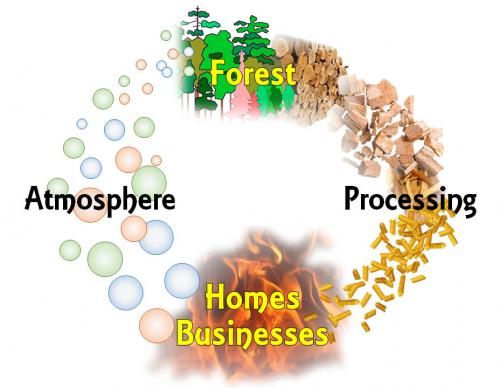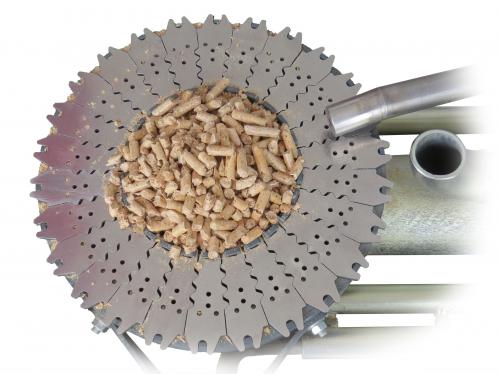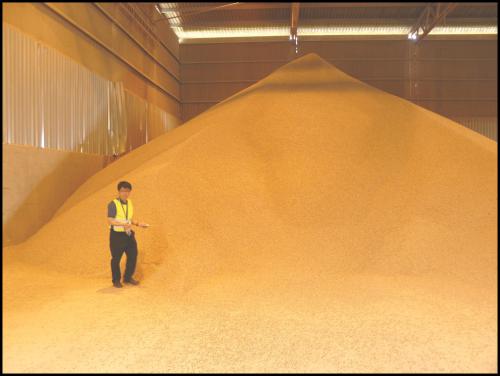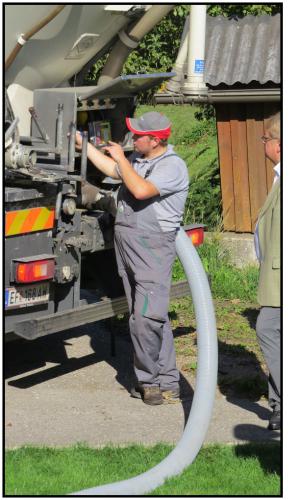Bulk Pellets
Bulk Wood Pellet Delivery Systems
In order to effectively replace residential and small business fossil fuel use with renewable heating fuels, fuel delivery and system operation need to be about as seamless to the user as current fossil fuel systems. Therefore, a bulk delivery system would be essential to support a market. Yet, a market needs to exist before a bulk delivery network can become financially viable. Thus, a catch-22 of sorts.
The Vision
The big picture idea is to heat our homes, offices, shops and institutions with locally grown and produced, renewable premium wood pellets or wood chips, rather than expensive, foreign (or domestic), polluting fossil fuels. Also, to do this with advanced, automated appliances and systems that are safe, convenient, clean and affordable.
- These advanced furnaces (hot air) and boilers (hot water) are as automatic as conventional appliances. These are not wood pellet stoves or backyard boilers.
- Wood pellets are delivered in the same manner as propane or fuel oil, to a storage bin, similar to the propane or fuel oil tank you might have now.
- The Wood Energy Team and partners are working to pilot a program in southwest Michigan.
For the Homeowner
Early-adopter homeowners would install a wood pellet furnace (forced air) or boiler (radiator system) simply for environmental reasons, even when the installation costs are higher than traditional devices. These people may also be willing to hand-fill a hopper with standard forty-pound bags, until a bulk delivery service can be built. However, it will be difficult to find a certified installer (few in Michigan) and a vendor of these high-tech appliances. But, the vision for an economic driver in Michigan involves tens of thousands of homeowners and small businesses that currently burn more expensive fuels, with greater price volatility and damaging environmental impacts. If existing models in New England and Europe are examples, then both incentives and time will be required.
Advantages of Advanced Wood Pellet Heating Systems
- Appliances are guaranteed reliable for over 30 years.
- Fuel prices are stable and affordable.
- Keeps energy dollars working in local economies.
- Less fossil fuel pollution.
- These “green” systems promote forest health and reduce waste.
Challenges in Achieving a Working Business Model
- Systems are initially expensive, but are affordable over the life of the system.
- These systems are new and unfamiliar to most Michigan homeowners, but are common in New England and Europe.
- Dealers and installers in Michigan are equally unfamiliar.
- Premium wood pellets cannot be delivered in bulk, yet, because Michigan lacks the delivery infrastructure.
- Experience shows that deploying these systems requires incentives, or a fossil fuel crisis.
Positive Forest & Environmental Impacts
- Management Flexibility - More markets yield more management options and more management leads to better forests.
- Healthier Trees - Related to the above but management does, indeed provide more products and services than unmanaged forests, including healthier trees that are more resilient to pests.
- Low-grade Materials - These materials are removed to shape longer-term desired future conditions of forests, creating higher quality trees or other forest characteristics. Markets for these materials are often lacking.
- Inventory Monitoring - Forest monitoring needs to continue, perhaps intensity, in order to better understand the effects of management activities the roles of various wood product markets.
- Regional Differences - Forest conditions and growth-harvest-mortality ratios vary across the state and from statewide averages.
- Environmental Benefits - Wood is the most environmentally-friendly raw material at our disposal. Within the limits of natural productivity, wood should be used whenever possible, including the low-hanging fruit of heating and cooling technologies.
Timber Harvest
Responsible wood use begins with responsible harvest. Michigan adds huge volumes of wood to its inventory each year. A portion of that growing inventory could be used for increased benefits to society. Wood processing from forest to front door.
- Transportation - This involves the use of fossil fuels, the same as delivering any other heating fuel or manufactured goods.
- Mill Residues / Roundwood - These are the first choice for pellet manufacturing. However, as the wood pellet market grows it will soon consume residues and will need to turn to wood directly from the forest. This will increase the cost of pellet manufacturing.
- Pellet Manufacturing - There are several pellet mills across the state that currently operate under capacity. Nevertheless, should the pellet demand become an important economic driver, as in other regions of the U.S., there will come a point where additional mills will be necessary.
- Pellet Quality & Standards - Premium wood pellets now have regulated standards. This was not the case earlier in the wood pellet manufacturing era.
- Supply Stability - Raw product supply is certainly a
 concern, yet we have barely scratched the surface of what could be available. The need for heat (and cooling) requires an uninterrupted supply chain, either for wood-based products or for fossil fuels.
concern, yet we have barely scratched the surface of what could be available. The need for heat (and cooling) requires an uninterrupted supply chain, either for wood-based products or for fossil fuels. - Local Economy - Because forest products such as chips, logs and pulpwood, as well as wood pellets are bulky, low-value materials, they cannot be economically transported very far. This translates into the need for local and regional markets, unlike fossil fuels. Keeping energy dollars local can be an important economic driver.
Home & Business Benefits
- Public Awareness - Most people are unaware of the advanced technologies for wood pellet heating. These modern appliances are furnaces and boilers, not wood stoves or old-style dirty backyard cordwood boilers (there are now some highly efficient backyard boilers on the market, too).
- Site Conditions - Each site has a number of variables that translate into the viability of installing a wood pellet heating system.
- Installation & Operating Costs - Wood pellet systems are more expensive to install but typically have lower operating costs and the appliances last longer than conventional appliances. This will be more attractive to those with long-term interest in a home or other building.
- Appliance Quality & Technology - There are choices in selecting appliances and technologies. Not only does one tend to "get what you pay for", but there are also different levels of homeowner engagement, from simply "turning the thermostat" to loading pellet hoppers yourself.
- System Longevity - Higher-end (and higher cost) appliances have lifetimes of at least 30-35 years.
- HVAC Installers - Most installers are also not aware of these advanced, modern appliances.
- Pellet Trucks - These are specialized pneumatic trucks that deliver wood pellet in a dust-free condition. They are expensive, typically around $250,000 and therefore require sufficient markets to pay for themselves.
 Insurance / Building Codes - These high-tech appliances come with the usual safety coding as gas or fuel oil appliances. However, the novelty of these wood pellet appliances sometimes causes local agents to emplace restrictions.
Insurance / Building Codes - These high-tech appliances come with the usual safety coding as gas or fuel oil appliances. However, the novelty of these wood pellet appliances sometimes causes local agents to emplace restrictions.- Lending / Incentives (New England examples) - Nearly all regions where wood pellet or wood chip technologies have become essential economic drivers were intitally grown with financial incentives.
Atmospheric Carbon & Residues
- Emissions - These advanced appliances meet or beat air quality standards, anywhere.
- Carbon Cycle - Much has said about carbon emissions of wood-based fuels. The most important point, perhaps is that all the carbon from burning wood recently came from the atmosphere, soon goes back into forests and is part of the natural carbon cycle. All carbon from burning any amount of fossil fuels was sourced outside the carbon cycle.
- Ash Disposal - Once or twice per year, a modern wood-pellet appliance will need to have an ash bin emptied. The appliances do not need to be cleaned any more often than conventional furnaces.
- Offset Fossil Fuel Use - This is where burning wood for heat has its greatest environmental advantage. By consuming less fossil fuel and other sources of inorganic carbon, that much less carbon gets released in the carbon cycle. Forest carbon can be burned for centuries with little impact on atmospheric carbon . . . as long as the forest remains as forest (an important caveat).
References & Links
- Feel Good Heat
- Biomass Thermal Energy Council
- Northern Forest Center
- Maine Energy Systems
- Maine Energy Systems Videos
- New Hampshire Wood Energy Council
Also, please see the two recently completed publications from the Vermont State Wood Energy Team:



 Print
Print Email
Email